Askey Computer TC7300B0M Cable Modem User Manual
Askey Computer Corp Cable Modem Users Manual
Users Manual.PDF
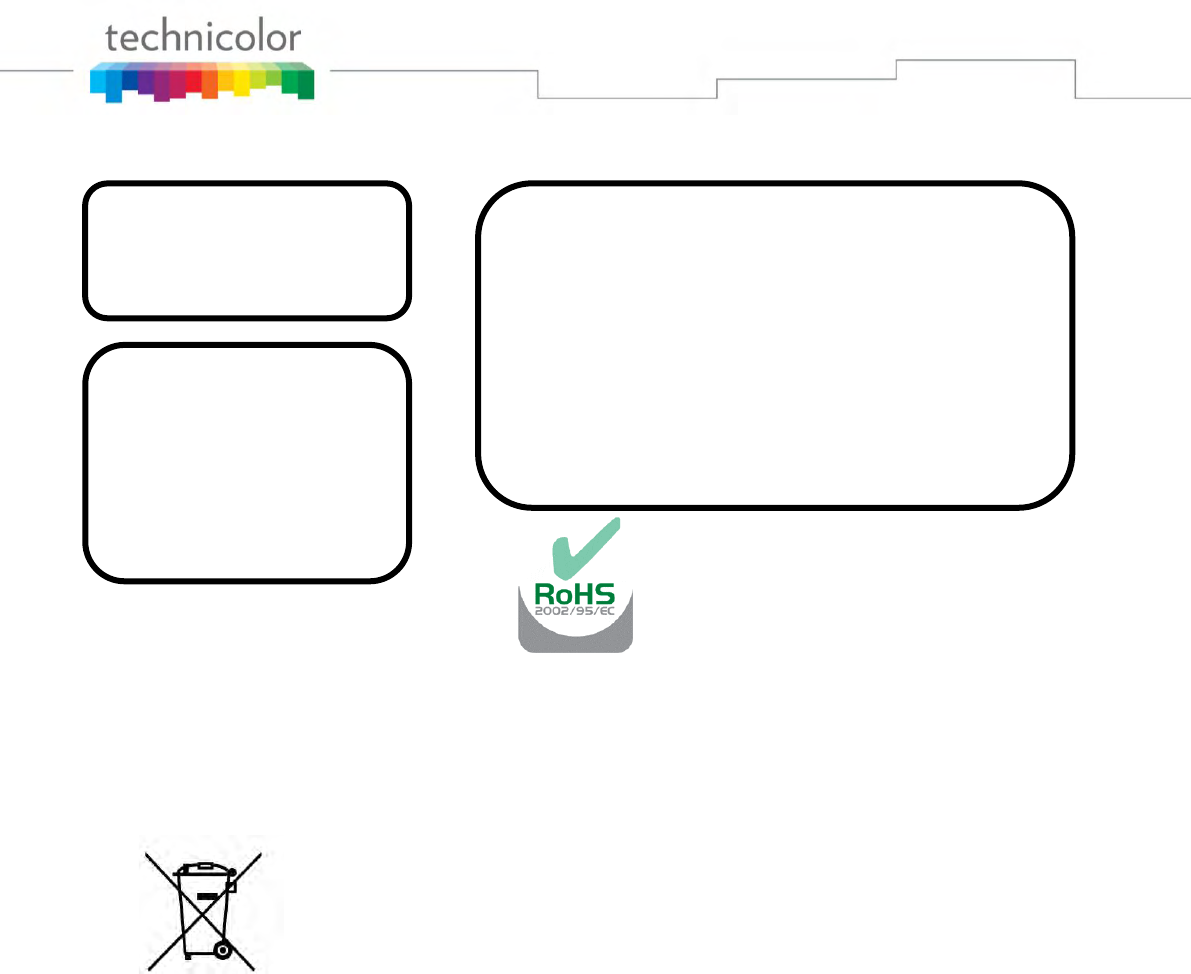
Page 1 / 22
This symbol means that your inoperative electronic appliance must be collected separately and not mixed with the
household waste. The European Union has implemented a specific collection and recycling system for which
producers' are responsible.
This appliance has been designed and manufactured with high quality materials and components that can be recycled
and reused. Electrical and electronic appliances are liable to contain parts that are necessary in order for the system to
work properly but which can become a health and environmental hazard if they are not handled or disposed of in the
proper way. Consequently, please do not throw out your inoperative appliance with the household waste.
If you are the owner of the appliance, you must deposit it at the appropriate local collection point or leave it with the
vendor when buying a new appliance.
- If you are a professional user, please follow your supplier's instructions.
- If the appliance is rented to you or left in your care, please contact your service provider.
Help us protect the environment in which we live!
CAUTION
Disconnect power before
servicing.
This device is intended for
indoor operation only.
Telephone jacks Line 1 and
Line 2 must not be connected
to outside wiring.
CAUTION
To ensure reliable operation and to prevent overheating,
provide adequate ventilation for this modem and keep it
away from heat sources. Do not locate near heat registers
or other heat-producing equipment. Provide for free air
flow around the Wireless Voice Gateway and its power
supply.

Page 2 / 22
NORTH AMERICAN CABLE INSTALLER:
This reminder is provided to call your attention to Article 820-40 of the National Electrical Code (Section
54 of the Canadian Electrical Code, Part 1) which provides guidelines for proper grounding and, in
particular, specifies that the cable ground shall be connected to the grounding system of the building as
close to the point of cable entry as practical.
Operating Information
Operating Temperature: 0˚ - 40˚ C (32˚ - 104˚ F)
Storage Temperature: -20˚ to 70˚ C (-4˚ – 158˚ F)
If you purchased this product at a retail outlet, please read the following:
Product Information
Keep your sales receipt to obtain warranty parts and service and for proof of purchase. Attach it here and
record the serial and model numbers in case you need them. The numbers are located on the back of the
product.
Model No. ____________________________Serial No ________________________________
Purchase Date: ________________________Dealer/Address/Phone: _________________________

Page 3 / 22
Safety Recommendations
REMEMBER SAFETY FIRST
Using equipment safely
Your Cable Modem has been manufactured to meet safety standards, but you must take care if you want it
to perform properly and safely.
It is important that you read this booklet completely, especially the safety instructions below. If you have
any doubts about the installation, operation or safety of decoder, please contact your supplier.
To avoid the risk of electric shock
Disconnect the Cable Modem from the mains supply before you connect the Cable Modem to (or
disconnect it from) any other equipment. Remember that contact with 110 ~ 240 Volt AC mains can
be lethal or cause severe electric shock.
Never remove the Cable Modem’s cover. Should the Cable Modem fail, contact the Customer Service
to arrange repair or service.
Never allow anyone to push anything into holes, slots or any other opening in the case
Do not block the Cable Modem’s ventilation slots; never stand it on soft furnishings or carpets
Do not put anything on the Cable Modem which might spill or drip into it (eg. Lighted candles or
containers of liquids). Do not expose the Cable Modem to dripping or splashing. If an object or liquid
enters inside the Cable Modem, unplug it immediately and contact the Customer Service.
Do not store the Cable Modem in excessively hot, cold or damp conditions. The Cable Modem is
intended to operate at an ambient temperature of less than 40 degrees Celsius and a maximum
humidity level of 75%. In case of a storm, it is recommended that you unplug the Cable Modem from
the mains and from the TV set.
Leave the mains socket accessible so that you can unplug the set quickly
Connecting to the mains supply
This Cable Modem is designed to operate at 100 ~ 240 VAC.
If you are in any doubt about the mains lead, the plug or connection, please consult the Customer
Service.
Only the power adapter supplied with the decoder has to be used
Ensuring optimum performance
Leave 7cm to 10cm around the Cable Modem to ensure that proper ventilation gets to the Cable
Modem.
Do not store your Cable Modem on its side (if not allowed)
To clean the Cable Modem, use a dry, clean soft cloth with no cleaning solvent or abrasive products.
Clean the ventilation openings regularly.
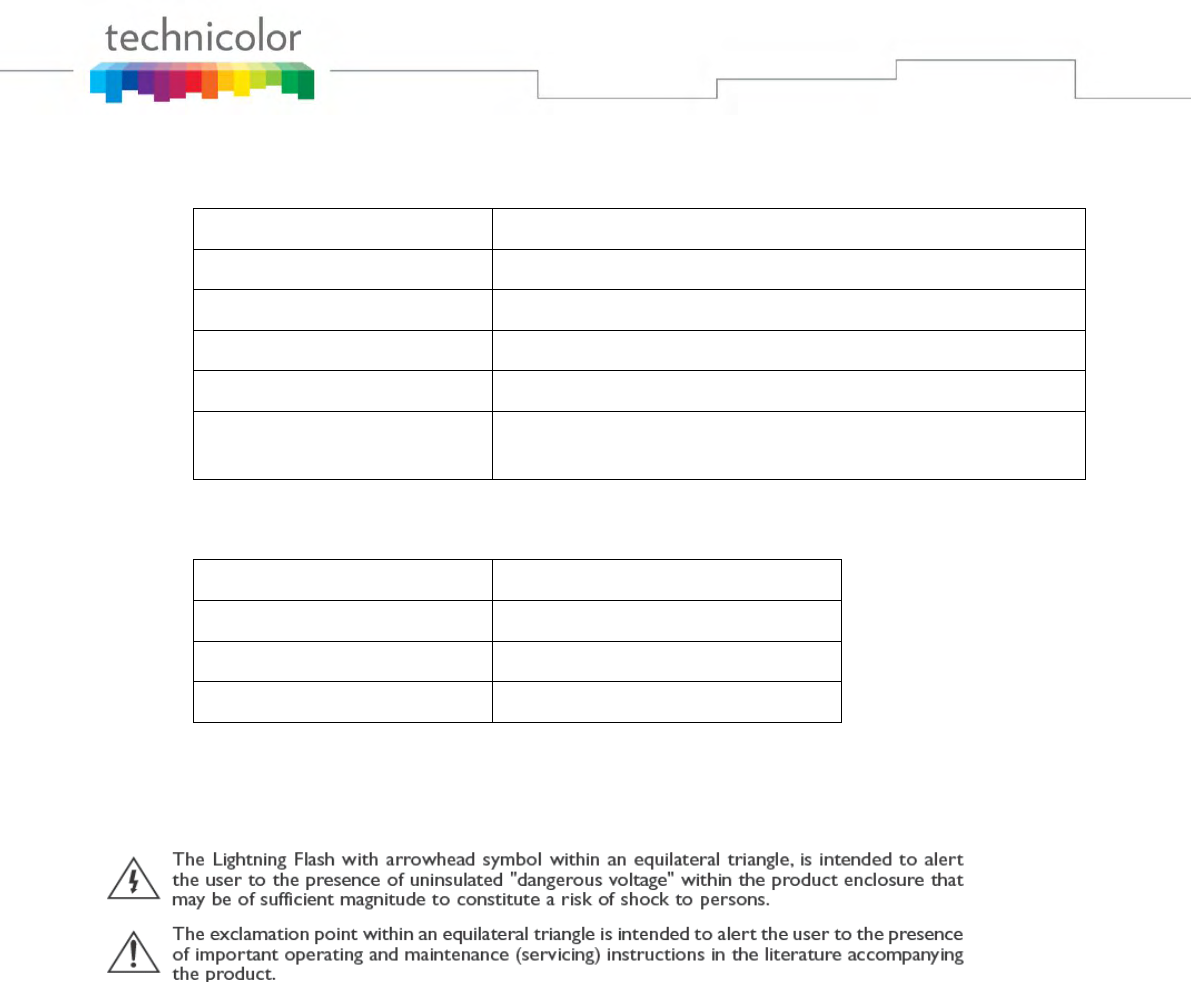
Page 4 / 22
MAIN TECHNICALSPECIFICATIONS
General
Operating voltage
100 ~ 240 VAC
Typical Power consumption
18W max
Dimensions (W x H x D)
177mm x 142.07mm x 51.3mm
Operating temperature range
0 – 40 °C
Storage temperature range
-20 – 70 °C
AC adapter (or plug-in
adapter) type
ADAPTER 18W 12VDC/1.5A
Connections
DC input
12V/ 1.5A
Cable input
1x Coaxial cable connector
Phone plugs
2x RJ11
Ethernet plugs
2x RJ-45

Page 5 / 22
Chapter 1: Connections and Setup ............................................................................................. 6
Turning on the Wireless Voice Gateway ......................................................................................... 6
Introduction ........................................................................................................................... 6
Wireless Voice Gateway Features ............................................................................................. 6
Computer Requirements ......................................................................................................... 7
Wireless Voice Gateway Overview ............................................................................................... 8
Front Panel ......................................................................................................................... 8
Rear Panel ........................................................................................................................ 10
Side Panel for WPS ............................................................................................................. 10
Relationship among the Devices ............................................................................................. 11
What the Modem Does ......................................................................................................... 11
What the Modem Needs to Do Its Job ...................................................................................... 11
Contact Your Local Cable Company ........................................................................................ 11
Connecting the Wireless Voice Gateway to a Single Computer ........................................................... 12
Attaching the Cable TV Wire to the Wireless Voice Gateway ........................................................ 13
Installation procedure for connecting to the Ethernet interface ........................................................ 14
Telephone or Fax Connection ................................................................................................ 15
Chapter 2: Additional Information ........................................................................................... 16
Frequently Asked Questions ..................................................................................................... 16
General Troubleshooting .......................................................................................................... 18
Service Information ................................................................................................................ 19
Glossary .............................................................................................................................. 20
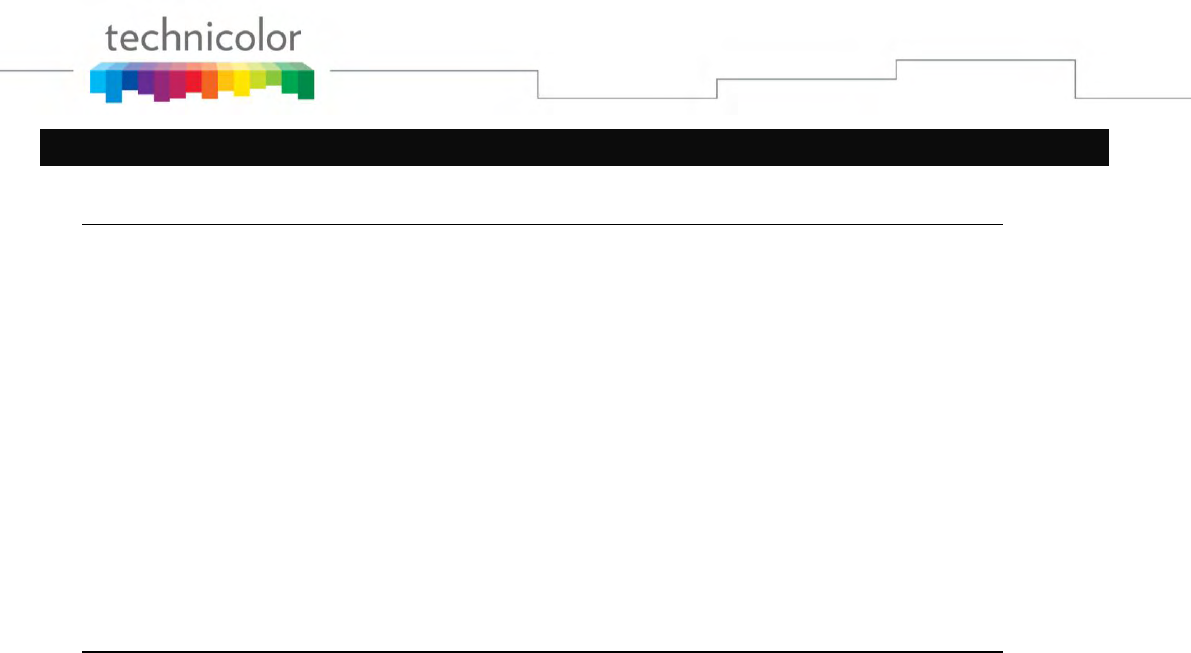
Page 6 / 22
CHAPTER 1: CONNECTIONS AND SETUP
Turning on the Wireless Voice Gateway
After installing the Wireless Voice Gateway and turn it on for the first time (and each time the modem is
reconnected to the power), it goes through several steps before it can be used. Each of these steps is
represented by a different pattern of flashing lights on the front of the modem.
If there is no lighted LEDs on the front panel, check the power adapter plug-in the power jack and
connect to CM correctly.
Note: All indicators flash once before the initialization sequence.
If both DS and US LEDs are flashing, it means the Wireless Voice Gateway is automatically updating its
system software. Please wait for the lights to stop flashing. Do not remove the power supply or reset the
Wireless Voice Gateway during this process.
Introduction
Wireless Voice Gateway Features
Full Band Capture Front End
Brand new technology provides high performance while maintaining low power consumption.
Excentis EuroDOCSIS 1.0/1.1/2.0/3.0 Standard Compliant.
PacketCable 1.0/1.5 Standard Compliant and upgradeable to PacketCable 2.0 version)
Two Standard RJ-45 connector for 10/100/1000BaseT Ethernet with auto-negotiation and MDIX
functions; Support maximum Ethernet cable length up to 100m (Category 5e).
Support simultaneous voice and data communications.
Two RJ-11 Foreign Exchange Station (FXS) port for IP telephony (TEL-1 and TEL-2); Support a
maximum line length between themselves and an end-receiver (handset, etc.) of up to 500 feet (AWG
26/0.4mm). TEL-1 and TEL-2 port are not connected on Hardware side.
One voice conversations in the FXS port with different CODEC: G.711‐ulaw, G.711‐
alaw, G.723.1, BV16, ILBC, G.726‐16, G.726‐24, G.726‐32, G.726‐40,
G.728, G.729, G.729E, G.729A, G.729B, TELEVENT, T.38 (disabled by default); Support V.90 fax
and modem services.
Default codecs: G.711‐ulaw, G.711‐alaw, BV16, ILBC, TELEVENT, T.38 (disabled by default)
Support Various function to provide high quality voice including: Echo Cancellation, Voice Active
Detection (VAD), DTMF detection and generation and Comfort Noise Generation (CNG).
Single 2.4GHz WiFi interface provides standard 802.11 b/g/n support, 20/40Mhz bandwidth, up to
200Mbps data rate.
The NTP (Network Termination Point) should be able to operate with an LF (Loading Factors) of at
least 5 REN.
Support Web pages and private DHCP server for status monitoring. SNMP network management
support also provided
DOCSIS and PacketCable are trademarks of Cable Television Laboratories, Inc.
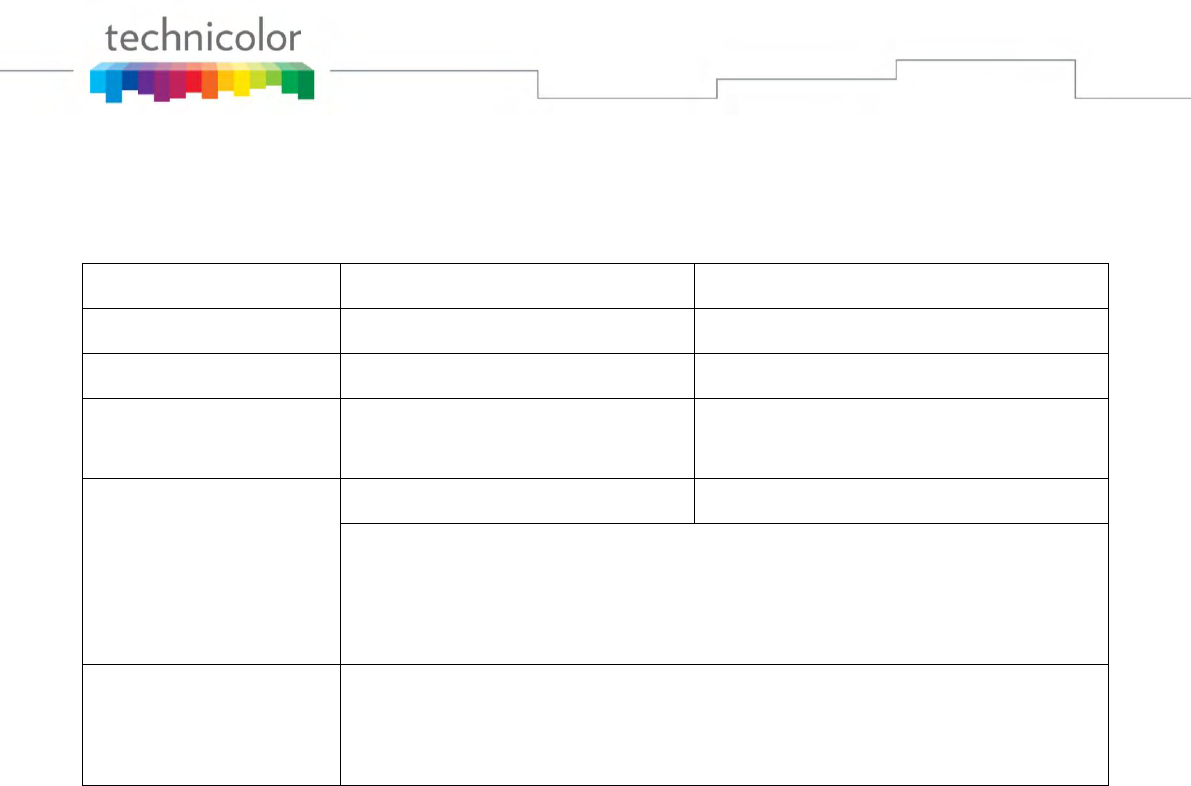
Page 7 / 22
Computer Requirements
For the best possible performance from your Wireless Voice Gateway, your personal computer must meet
the following minimum system requirements (note that the minimum requirements may vary by cable
companies):
IBM PC COMPATIBLE
MACINTOSH**
CPU
Pentium or higher.
PowerPC or higher
System RAM
16MB or Higher
24MB or Higher
Operating System
Windows* NT / 2000 / Me / XP /
Vista / Windows 7, Linux
Mac OS** 7.6.1 or higher
Ethernet
10BaseT , 100BaseT or 1000BaseT
10BaseT , 100BaseT or 1000BaseT
An Ethernet card makes it possible for your computer to pass data to and from
the internet. You must have an Ethernet card and software drivers installed in
your computer. You will also need a standard Ethernet cable to connect the
Ethernet card to your Wireless Voice Gateway.
Software
A TCP/IP network protocol for each machine
Microsoft Internet Explorer, Mozilla Firefox, Google Chrome, or
equivalent.
* Windows is a trademark of Microsoft Corporation.
** Macintosh and the Mac OS are trademarks of Apple Computer, Inc.
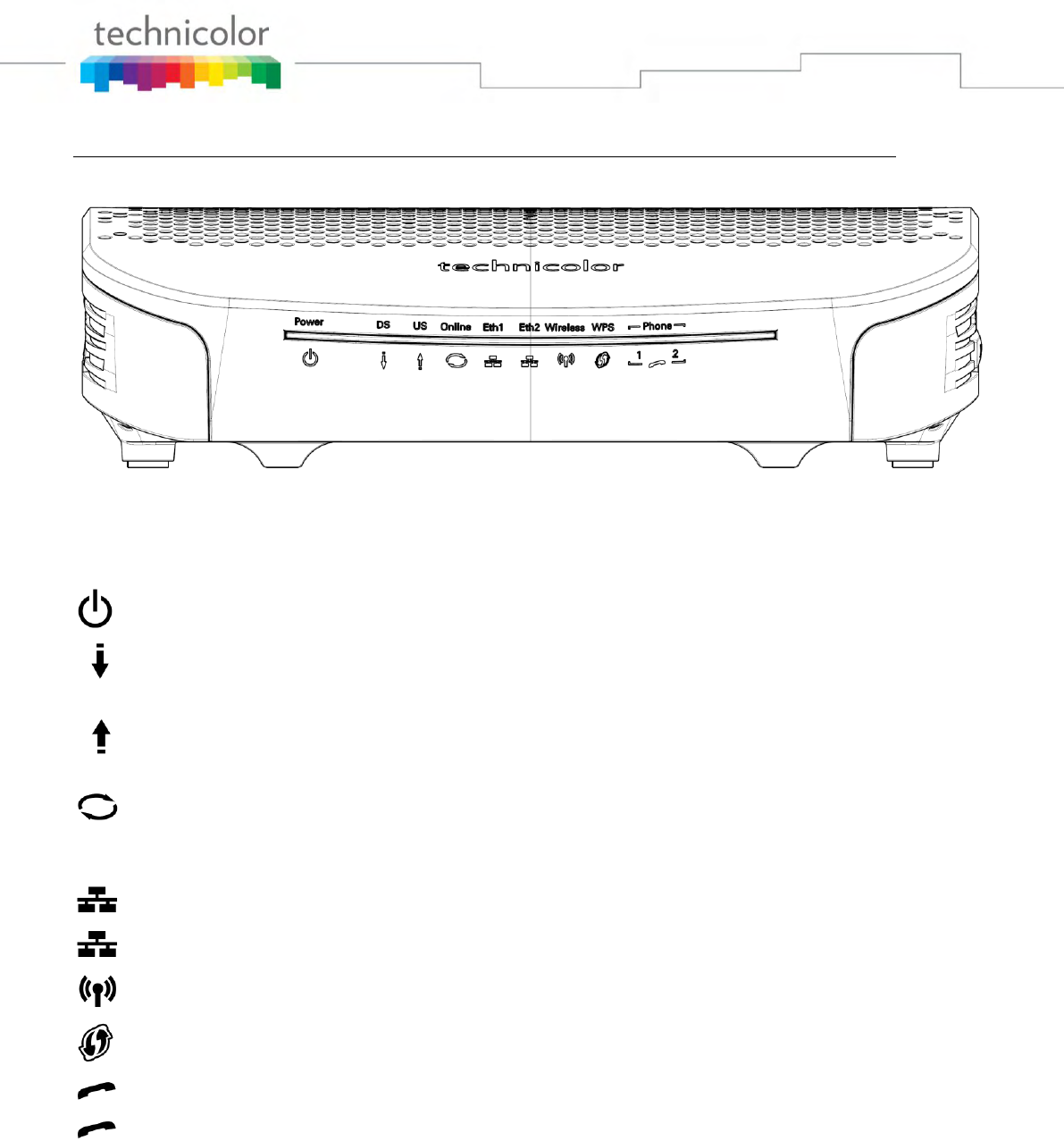
Page 8 / 22
Wireless Voice Gateway Overview
Front Panel
Fig. 1-1 Front Panel
The following illustration shows the front panel:
Power - Indicates the Power status.
DS - Indicates the status of Data reception by the cable modem from the Network (Downstream
Traffic).
US - Indicates the status of Data transmission by the cable modem to the Network (Upstream
Traffic).
Online - Displays the status of your cable connection. The light is off when no cable connection is
detected and fully lit when the modem has established a connection with the network
and data can be transferred.
Eth1 - Indicates the state of Ethernet ports.
Eth2 - Indicates the state of Ethernet ports.
Wireless - Indicates the traffic on the wireless network.
WPS - Indicates the status of the WPS functionality.
Phone1 - Indicates the status of the telephone Phone 1.
Phone2 - Indicates the status of the telephone Phone 2.
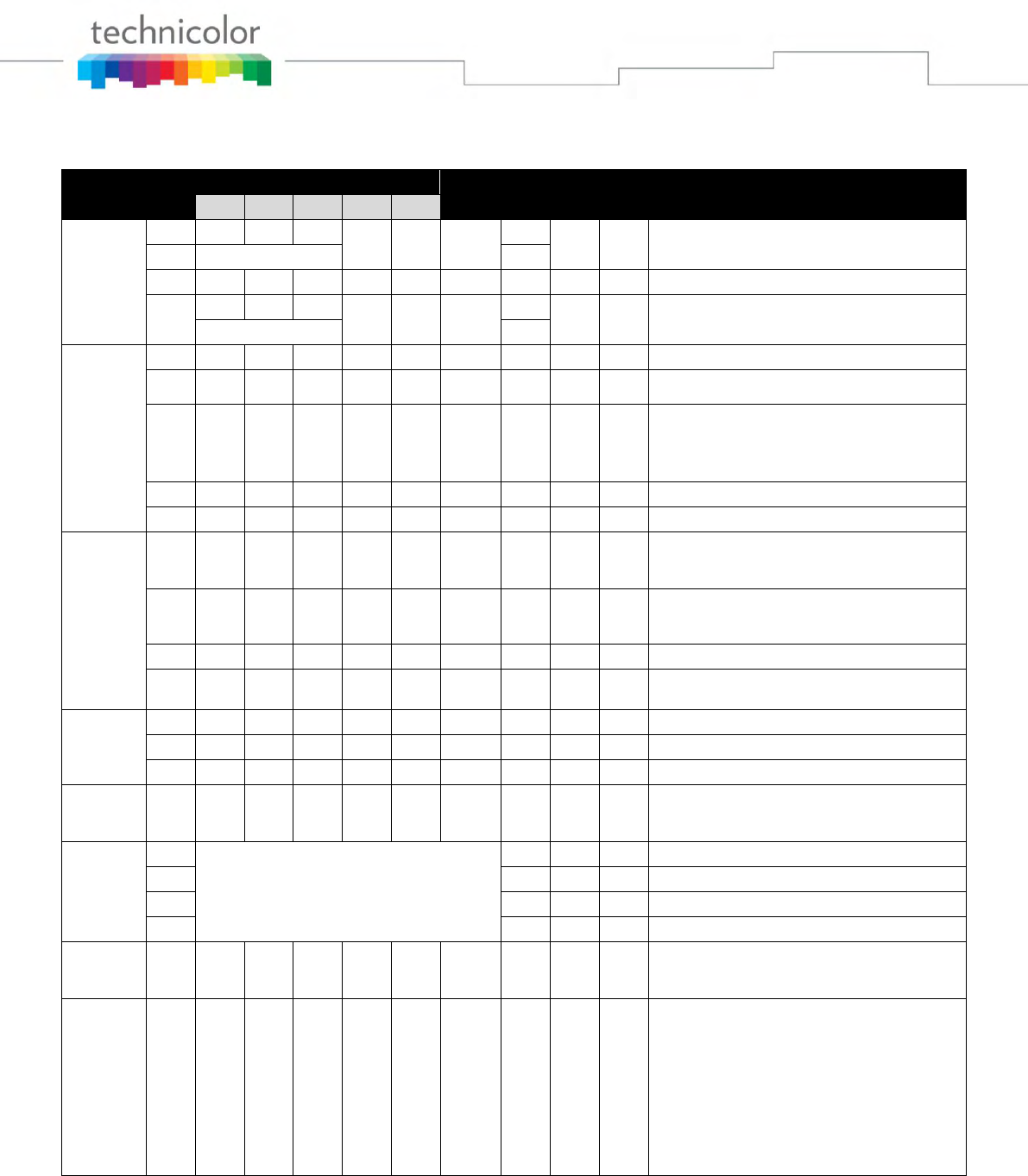
Page 9 / 22
The lights on the front panel LEDs are described in the table below (from left to right):
ON = the LED is light, OFF = the LED is gray, FLASH = the LED is blinking.
Power
Internet
Ethernet
Wireless
WPS
TEL 1
TEL 2
Description
DS
US
Online
1
2
Boot-up
Operation
ON
ON
ON
ON
ON
ON
X
X
ON
ON
Power on 0.25 sec
ON
0.25 second
ON
FLASH
FLASH
FLASH
X
X
X
X
X
X
From power ON to system initialization complete
ON
ON
ON
ON
X
X
X
X
X
X
Following system initialization complete to (before) DS
scanning
1 second
DOCSIS
Start-up
Operation
ON
FLASH
OFF
OFF
X
X
X
X
X
X
During DS scanning and acquiring SYNC
ON
ON
FLASH
OFF
X
X
X
X
X
X
From SYNC completed, receiving UCD to ranging
completed
ON
ON
ON
FLASH
X
X
X
X
X
X
During DHCP, configuration file download,
registration, and Baseline Privacy initialization:
DHCP status: 1 second ON and 1 second OFF,
TFTP status: 0.25 second ON and 0.25 second OFF
ON
ON
ON
ON
X
X
X
X
X
X
Operational (NACO=ON)
ON
FLASH
FLASH
OFF
X
X
X
X
X
X
Operational (NACO=OFF)
Channel
Bonding
Operation
FLASH
FLASH
FLASH
FLASH
X
X
X
X
X
X
Wait registration with all DS and all US – Lights Flash
sequentially from the right to left Minimum duration 3
seconds
X
X
X
X
X
X
X
X
X
X
From 1 to 4 DS, from 1 to 4 LEDs are ON
From 5 to 8 DS, From 1 to 4 LEDs are flashing
Duration 3 seconds
OFF
X
X
X
X
X
X
X
X
X
From 1 to 4 US, from 1 to 4 LEDs are ON.
FLASH
FLASH
FLASH
FLASH
X
X
X
X
X
X
Wait registration with all DS and all US – Lights Flash
sequentially from the left to right
MTA
initialization
ON
ON
ON
ON
X
X
X
X
FLASH
OFF
MTA DHCP
ON
ON
ON
ON
X
X
X
X
OFF
FLASH
MTA SNMP/TFTP
ON
ON
ON
ON
X
X
X
X
ON
ON
RSIP for NCS
CPE
Operation
ON
X
X
X
OFF
ON
FLASH
OFF
ON
FLASH
OFF
ON
FLASH
X
X
X
No Ethernet / Wireless Link
Ethernet / Wireless Link
TX/RX Ethernet / Wireless Traffic
MTA
Operation
ON
<CM Normal Operation>
ON
ON
Both Lines On-Hook
ON
FLASH
ON
Tel1 Off-hook, Tel2 On-hook
ON
ON
FLASH
Tel1 On-hook, Tel2 Off-hook
ON
FLASH
FLASH
Both Lines Off-Hook
SW
Download
Operation
ON
FLASH
FLASH
ON
X
X
X
X
X
A software download and while updating the FLASH
memory
WPS
Operation
ON
X
X
X
X
X
X
FLASH
ON
OFF
ON
X
X
(long press, > 3 seconds)
WPS WiFi association during client and AP linking
process, WPS LED RED color light Blinking.
After link established WPS LED Green color light ON
(short press,1- 3 seconds)
Disable WiFi transmission
Enable WiFi transmission
Note: Base on customer’s request ,disable
transmission by default
Table 1-1 LED behavior
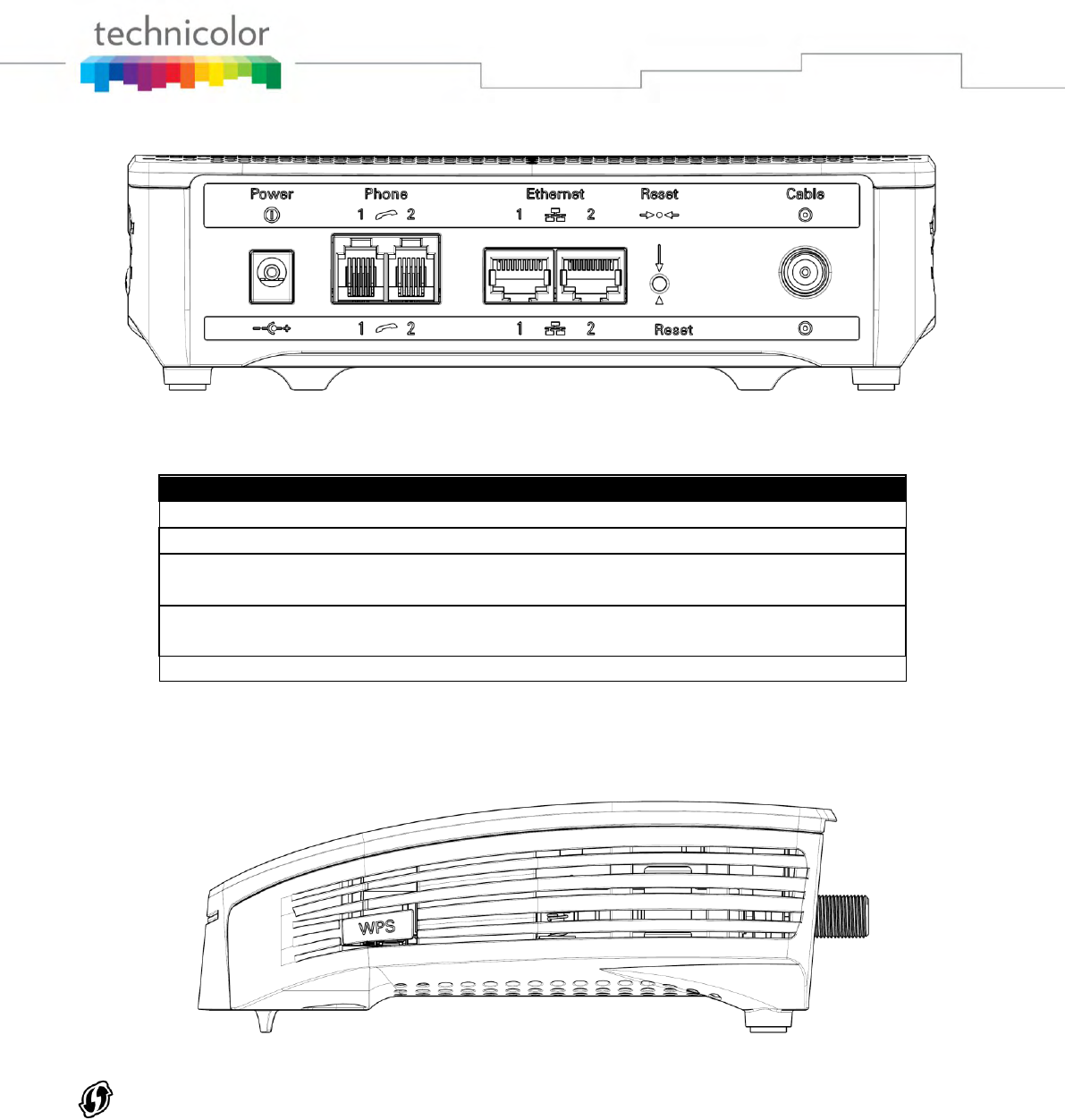
Page 10 / 22
Rear Panel
Fig. 1-2 Rear Panel
Connector
Description
Power Jack
Connector for DC12V.
Phone1/ Phone2
2 Phone RJ11 Connectors.
Etherent
2 Giga Ethernet ports, 10/100/1000 BaseT RJ-45
connector.
Reset
To restart the modem or press over 5 seconds can default
the modem.
Cable
Connector for the cable network.
Table 1-2 Rear Panel description
Side Panel for WPS
Fig. 1-3 Side Panel
WPS – Indicates the status of the WPS functionality.
WPS button: Wi-Fi Protected SetupTM. This button can be used to:
Secure the connection with another device (PC for example) using WPS protocol. A long press (press
3 more seconds) on the button allows you to enable the association of the modem with a PC or other
equipment.
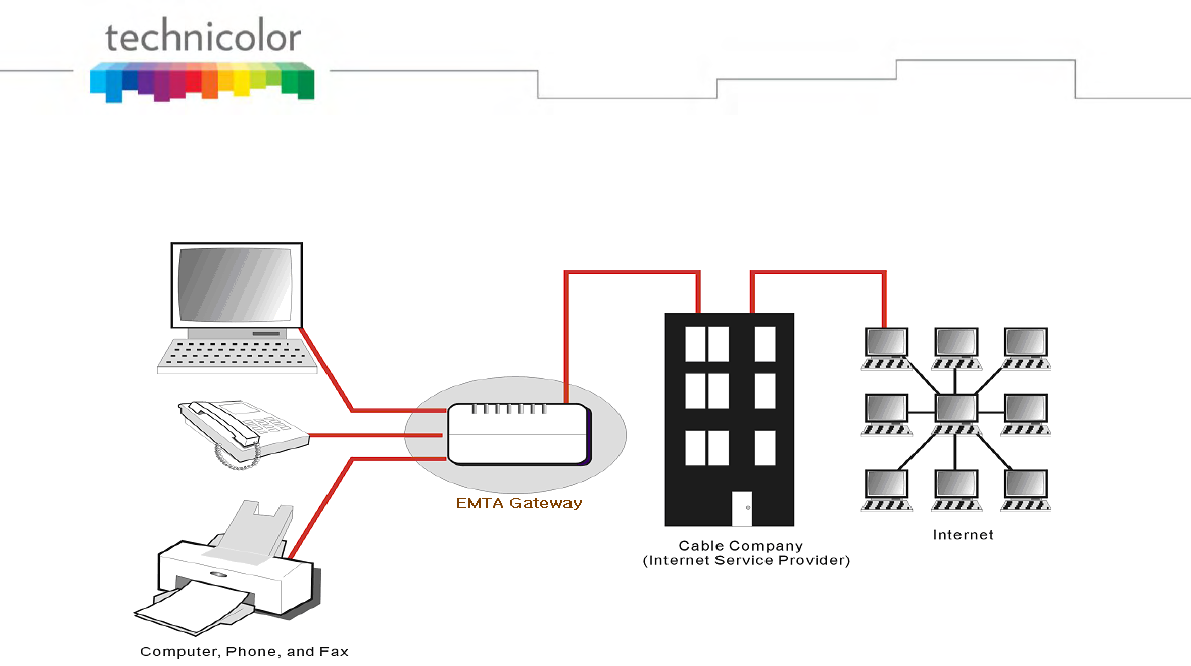
Page 11 / 22
Relationship among the Devices
This illustration shows a cable company that offers DOCSIS/Euro-DOCSIS and PacketCable/Euro-
PacketCable compliant voice/data services.
Fig. 1-5 Connection overview
What the Modem Does
The Wireless Voice Gateway provides high-speed Internet access as well as cost-effective, toll-quality
telephone voice and fax/modem services over residential, commercial, and education subscribers on
public and private networks via an existing CATV infrastructure. It can inter-operate with the
PacketCable compliant head-end equipment and provide the IP-based voice communications. The IP
traffic can transfer between the Wireless Voice Gateway and DOCSIS/Euro-DOCSIS compliant head-end
equipment. The data security secures upstream and downstream communications.
What the Modem Needs to Do Its Job
The Right Cable Company: Make sure your local cable company provides data services that use
cable TV industry-standard DOCSIS/Euro-DOCSIS compliant and PacketCable/Euro-
PacketCable compliant technology.
The Internet/Telephony Service Provider (ISP/TSP): Your cable company provides you access
to an Internet Service Provider (ISP) and Telephony Service Provider (TSP). The ISP is your
gateway to the Internet and provides you with a pipeline to access Internet content on the World
Wide Web (WWW). The TSP provides you with telephony access to other modems or other
telephony services over the Public Switched Telephone Network (PSTN).
Check with your cable company to make sure you have everything you need to begin; they’ll know if you
need to install special software or re-configure your computer to make your cable internet service work
for you.
Contact Your Local Cable Company
You will need to contact your cable company to establish an Internet account before you can use your
gateway. You should have the following information ready (which you will find on the sticker on the
gateway):
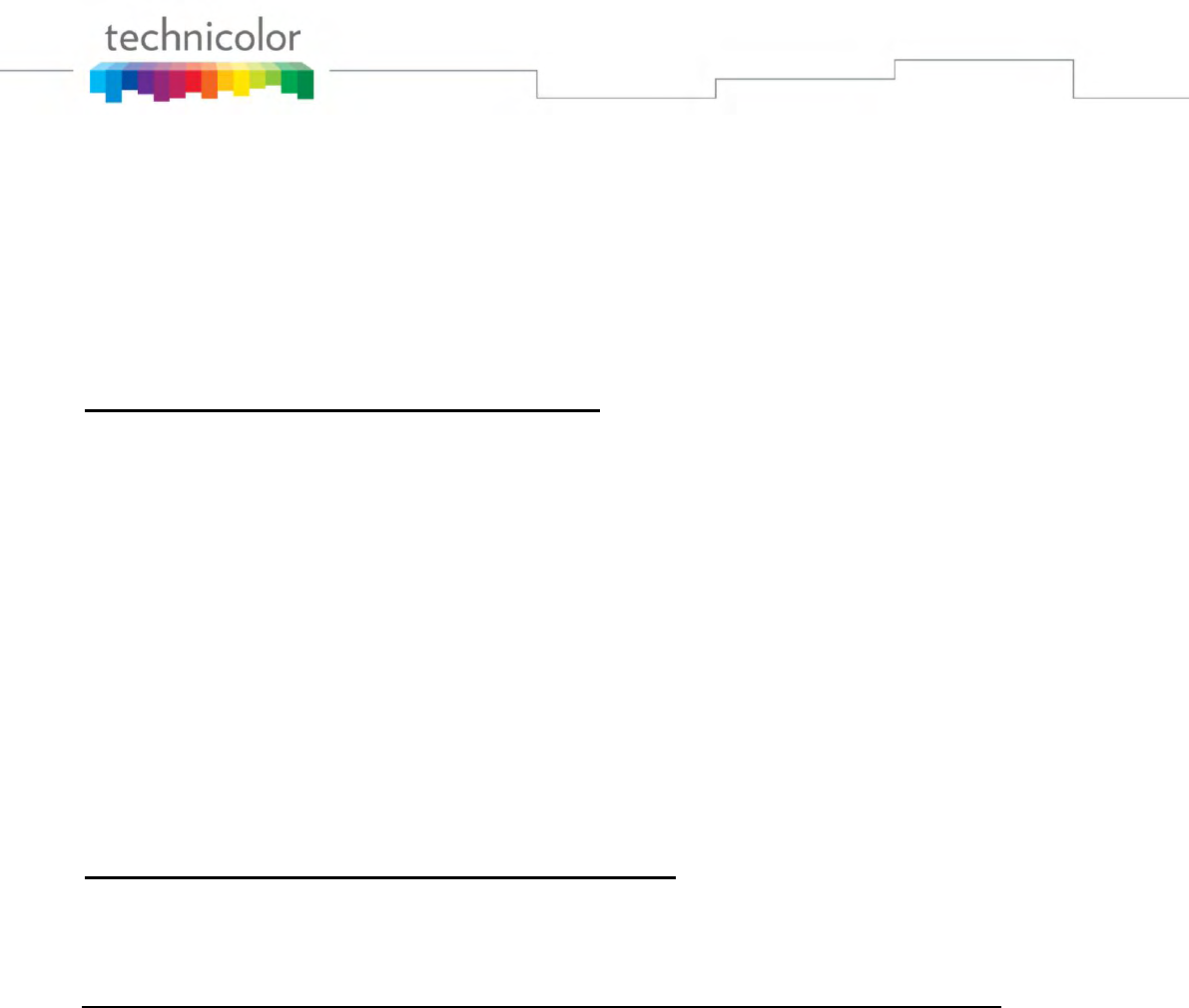
Page 12 / 22
The serial number
The model number
The Cable Modem (CM) Media Access Control (MAC) address
The Terminal Adapter (EMTA) MAC address
Security information: Service Set Identifier (SSID), Encryption key / passphrase (WPA2-PSK by
default), channel number. Default values are indicated underneath the modem on the sticker.
Please check the following with the cable company
The cable service to your home supports DOCSIS/Euro-DOCSIS compliant two-way modem
access.
Your internet account has been set up. (The Media Terminal Adapter will provide data service if
the cable account is set up but no telephony service is available.)
You have a cable outlet near your PC and it is ready for Cable Modem service.
Note: It is important to supply power to the modem at all times. Keeping your modem plugged in will
keep it connected to the Internet. This means that it will always be ready whenever you need.
Important Information
Your cable company should always be consulted before installing a new cable outlet. Do not attempt any
rewiring without contacting your cable company first.
Please verify the following on the Wireless Voice Gateway
The Power LED should be lighted when plug-in the power supply.
Connecting the Wireless Voice Gateway to a Single Computer
This section of the manual explains how to connect your Wireless Voice Gateway to the Ethernet port on
your computer and install the necessary software. Please refer to Figure 1-5 to help you connect your
Digital Cable Modem for the best possible connection.
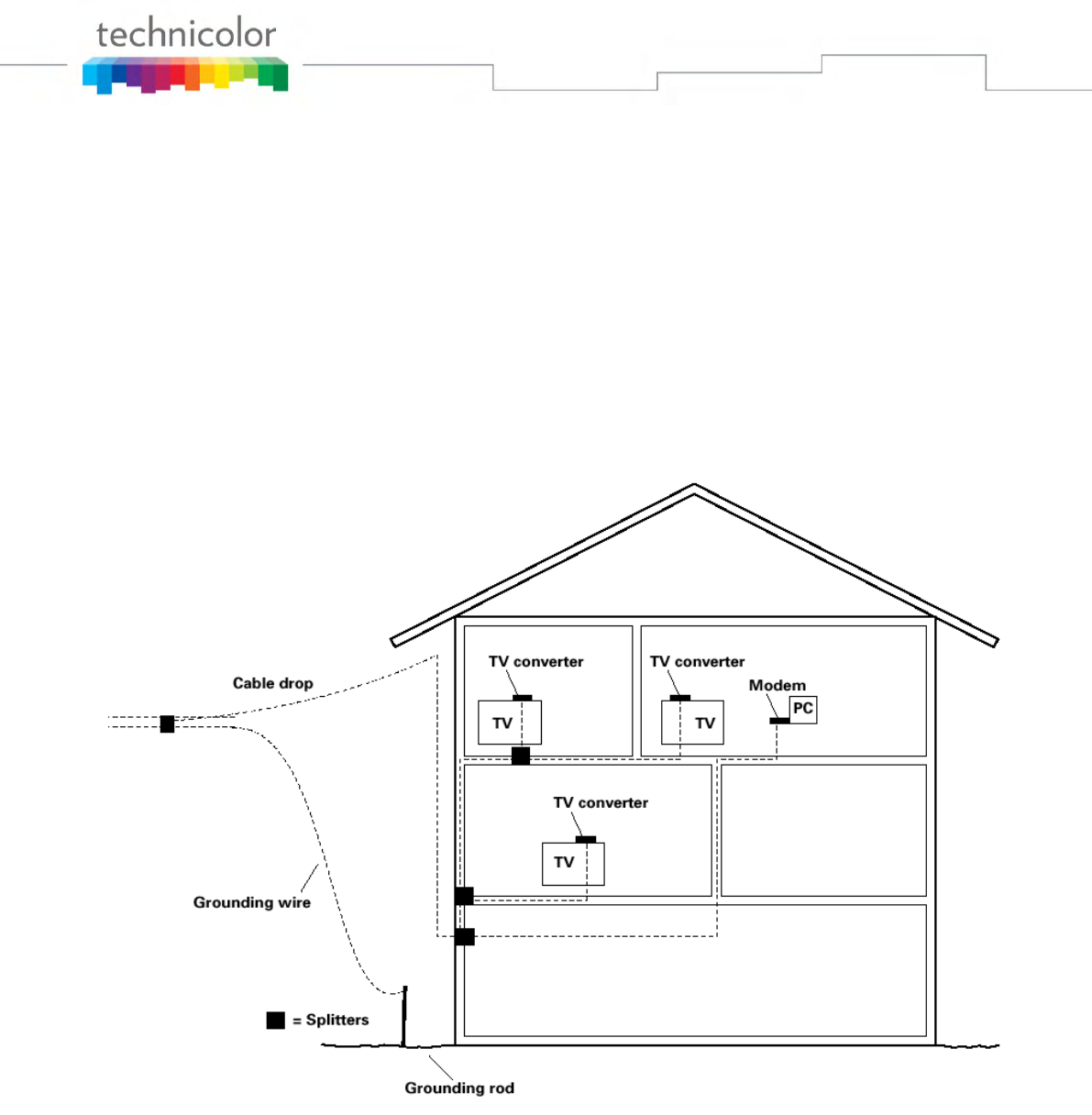
Page 13 / 22
Attaching the Cable TV Wire to the Wireless Voice Gateway
1. Locate the Cable TV wire. You may find it one of three ways:
a. Connected directly to a TV, a Cable TV converter box, or VCR. The line will be connected to
the jack, which should be labeled either IN, CABLE IN, CATV, CATV IN, etc.
b. Connected to a wall-mounted cable outlet.
c. Coming out from under a baseboard heater or other location. See Figure 1-6 for the wiring
example.
Notes: For optimum performance, be sure to connect your
Wireless Voice Gateway to the first point the cable enters
your home. The splitter must be rated for at least 1GHz.
Fig. 1-6 Basic Home Wiring
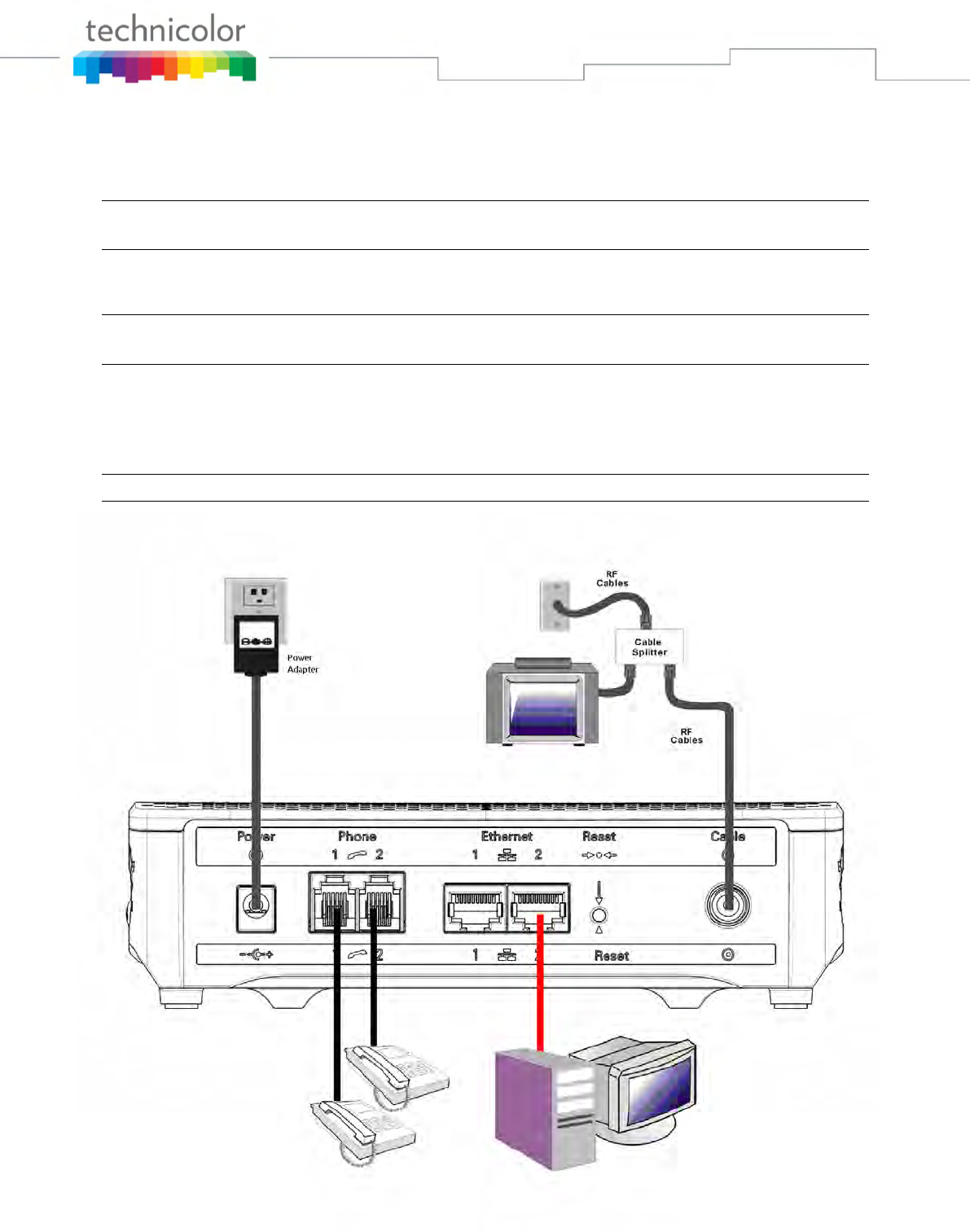
Page 14 / 22
Installation procedure for connecting to the Ethernet interface
Follow these steps for proper installation.
Plug the coaxial cable to the cable wall outlet and the other end to the modem’s cable connector.
Note: To ensure a fast registration of the modem, the coaxial cable must be connected to
the modem before it is powered on.
Plug the power adapter into the socket of the cable modem and two-pin plug in the AC outlet then press
the Power Switch, power on the modem.
Note: Only use the power adapter that comes with the modem. Using another power
adapter can cause damage to the product, and will void the warranty.
Connect an Ethernet cable (direct connection, see below) to the Ethernet port at the back of the computer,
and the other end to the ETHERNET port on the rear panel of the cable modem. The modem will seek the
appropriate cable signal on the cable television network and go through the initial registration process on
its own. The modem is ready for data transfer after the green LED "ONLINE" is lit continuously.
Note: the button "reset" at the back of the modem is used primarily for maintenance.
Fig. 1-7 Connect to the Modem

Page 15 / 22
Telephone or Fax Connection
When properly connected, most telephony devices can be used with the Wireless Voice Gateway just as
with a conventional telephone service. To make a normal telephone call, pick up the handset; listen for a
dial tone, then dial the desired number. For services such as call waiting, use the hook switch (or FLASH
button) to change calls. The following procedures describe some of the possible connection schemes for
using telephony devices with the Wireless Voice Gateway.
1. Connect a standard phone line cord directly from the phone (fax machine, answering machine, caller
ID box, etc.) to one of the LINE jacks on the Wireless Voice Gateway.
2. If there is a phone line in your home which is NOT connected to another telephone service provider,
connect a standard phone line cord from a jack on this line to one of the LINE jacks of the Wireless
Voice Gateway. Connect a standard phone line cord directly from the phone (fax machine, answering
machine, caller ID box, etc.) to one of the other jacks in the house that uses that line.
3. If you have a multi-line telephone, connect a standard phone line cord (not an RJ-14 type line cord)
from the phone to the LINE jacks on the Wireless Voice Gateway. (Other phones can be added to
each line by using standard phone line splitters.)

Page 16 / 22
CHAPTER 2: ADDITIONAL INFORMATION
Frequently Asked Questions
Q. What if I don’t subscribe to cable TV?
A. If cable TV is available in your area, data and voice service may be made available with or without
cable TV service. Contact your local cable company for complete information on cable services,
including high-speed internet access.
Q. How do I get the system installed?
A. Professional installation from your cable provider is strongly recommended. They will ensure proper
cable connection to the modem and your computer. However, your retailer may have offered a self-
installation kit, including the necessary software to communicate with your cable ISP.
Q. Once my Wireless Voice Gateway is connected, how do I get access to the Internet?
A. Your local cable company provides your internet service*, offering a wide range of services including
email, chat, and news and information services, and a connection to the World Wide Web.
Q. It seems that the wireless network is not working
A. Check the Wireless LED on the front panel. If it is no lighted, press on the WPS button shortly, less
than 1 second, on the side of the modem, and then check again the Wireless LED. If it is lighted, then
the Wireless transmission is enabled.
Q. Can I watch TV, surf the Internet, and talk to my friends through the Wireless Voice Gateway at the
same time?
A. Absolutely!
Q. What do you mean by “Broadband?”
A. Simply put, it means you’ll be getting information through a “bigger pipe,” with more bandwidth, than
a standard phone line can offer. A wider, “broader” band means more information, more quickly.
Q. What is DOCSIS and what does it mean?
A. “Data over Cable Service Interface Specifications” is the industry standard that most cable companies
are adopting as they upgrade their systems. Should you ever decide to move, the Wireless Voice
Gateway will work with all upgraded cable systems that are DOCSIS-compliant.
Q. What is PacketCable and what does it mean?
A. PacketCable is the industry standard for telephony services that most cable companies are adopting as
they upgrade their systems. Should you ever decide to move, the Wireless Voice Gateway will work
with all upgraded cable systems that are PacketCable compliant.
Q. What is Xpress Technology and what does it mean?
A. It is one of the popular performance-enhancing WiFi technologies, designed to improve wireless
network efficiency and boost throughput. It is more efficient in mixed environments, and it can work
with 802.11a/b/g networks. When Xpress is turned on, aggregate throughput (the sum of the individual
throughput speeds of each client on the network) can improve by up to 27% in 802.11g-only networks,
and up to 75% in mixed networks comprised of 802.11g and 802.11b standard equipment. The

Page 17 / 22
technology achieves higher throughput by re-packaging data, reducing the number of overhead control
packets, so that more useful data can be sent during a given amount of time.
* Monthly subscription fee applies.
** Additional equipment required. Contact your Cable Company and ISP for any restrictions or additional
fees.

Page 18 / 22
General Troubleshooting
You can correct most problems you have with your product by consulting the troubleshooting list that
follows.
I can’t access the internet.
Check all of the connections to your Wireless Voice Gateway.
Your Ethernet card may not be working. Check each product’s documentation for more information.
The Network Properties of your operating system may not be installed correctly or the settings may
be incorrect. Check with your ISP or cable company.
I can’t get the modem to establish an Ethernet connection.
Even new computers don’t always have Ethernet capabilities – be sure to verify that your computer
has a properly installed Ethernet card and the driver software to support it.
Check to see that you are using the right type of Ethernet cable.
The modem won’t register a cable connection.
If the modem is in Initialization Mode, the INTERNET light will be flashing. Call your Cable
Company if it has not completed this 5-step process within 30 minutes, and note which step it is
getting stuck on.
The modem should work with a standard RG-6 coaxial cable, but if you’re using a cable other than
the one your Cable Company recommends, or if the terminal connections are loose, it may not work.
Check with your Cable Company to determine whether you’re using the correct cable.
If you subscribe to video service over cable, the cable signal may not be reaching the modem.
Confirm that good quality cable television pictures are available to the coaxial connector you are
using by connecting a television to it. If your cable outlet is “dead”, call your Cable Company.
Verify that the Cable Modem service is DOCSIS compliant and PacketCable compliant by calling
your cable provider.
I don’t hear a dial tone when I use a telephone.
Telephone service is not activated. If the rightmost light on the Wireless Voice Gateway stays on
while others flash, check with your TSP or cable company. If the Wireless Voice Gateway is
connected to existing house telephone wiring, make sure that another telephone service is not
connected. The other service can normally be disconnected at the Network Interface Device located
on the outside of the house.
If using the second line on a two-line telephone, use a 2-line to 1-line adapter cable.
For more Usage and Troubleshooting Tips use the web site links provided on the CD-ROM:
www.technicolor.com

Page 19 / 22
Service Information
If you purchased or leased your Wireless Voice Gateway directly from your cable company, then
warranty service for the Digital Cable Modem may be provided through your cable provider or its
authorized representative. For information on 1) Ordering Service, 2) Obtaining Customer Support, or 3)
Additional Service Information, please contact your cable company. If you purchased your Wireless
Voice Gateway from a retailer, see the enclosed warranty card.

Page 20 / 22
Glossary
10/100/1000 BaseT – Unshielded, twisted pair cable with an RJ-45 connector, used with Ethernet LAN
(Local Area Network). “10/100/1000” indicates speed (10/100/1000 BaseT), “Base” refers to baseband
technology, and “T” means twisted pair cable.
Authentication - The process of verifying the identity of an entity on a network.
DHCP (Dynamic Host Control Protocol) – A protocol which allows a server to dynamically assign IP
addresses to workstations on the fly.
Ethernet adapters – A plug-in circuit board installed in an expansion slot of a personal computer. The
Ethernet card (sometimes called a Network Interface Card , network adapter or NIC) takes parallel data
from the computer, converts it to serial data, puts it into a packet format, and sends it over the
10/100/1000 BaseT LAN cable.
DOCSIS (Data Over Cable Service Interface Specifications) – A project with the objective of
developing a set of necessary specifications and operations support interface specifications for Cable
Modems and associated equipment.
F Connector – A type of coaxial connector, labeled CABLE IN on the rear of the Wireless Voice
Gateway that connects the modem to the cable system.
HTTP (HyperText Transfer Protocol) – Invisible to the user, HTTP is used by servers and clients to
communicate and display information on a client browser.
Hub – A device used to connect multiple computers to the Wireless Voice Gateway.
IP Address – A unique, 32-bit address assigned to every device in a network. An IP (Internet Protocol)
address has two parts: a network address and a host address. This modem receives a new IP address from
your cable operator via DHCP each time it goes through Initialization Mode.
Key exchange - The swapping of mathematical values between entities on a network in order to allow
encrypted communication between them.
MAC Address – The permanent “identity” for a device programmed into the Media Access Control layer
in the network architecture during the modem’s manufacture.
NID - Network Interface Device, the interconnection between the internal house telephone wiring and a
conventional telephone service provider’s equipment. These wiring connections are normally housed in a
small plastic box located on an outer wall of the house. It is the legal demarcation between the subscriber’s
property and the service provider’s property.
PacketCable – A project with the objective of developing a set of necessary telephony specifications and
operations support interface specifications for Wireless Voice Gateways and associated equipment used
over the DOCSIS based cable network.
PSTN (Public Switched Telephone Network) – The worldwide voice telephone network which
provides dial tone, ringing, full-duplex voice band audio and optional services using standard telephones.
Provisioning - The process of enabling the Media Terminal Adapter (MTA) to register and provide
services over the network.

Page 21 / 22
TCP/IP (Transmission Control Protocol/Internet Protocol) – A networking protocol that provides
communication across interconnected networks, between computers with diverse hardware architectures
and various operating systems.
TFTP - Trivial File Transfer Protocol, the system by which the Media Terminal Adapter’s configuration
data file is downloaded.
TSP - Telephony Service Provider, an organization that provides telephone services such as dial tone,
local service, long distance, billing and records, and maintenance.
Xpress Technology - One of the popular performance-enhancing WiFi technologies, designed to improve
wireless network efficiency and boost throughput. It is more efficient in mixed environments, and it can
work with 802.11a/b/g networks.

Page 22 / 22
Federal Communication Commission Interference Statement
This device complies with Part 15 of the FCC Rules. Operation is subject to
the following two conditions: (1) This device may not cause harmful
interference, and (2) this device must accept any interference received,
including interference that may cause undesired operation.
This equipment has been tested and found to comply with the limits for a
Class B digital device, pursuant to Part 15 of the FCC Rules. These limits
are designed to provide reasonable protection against harmful interference in a
residential installation. This equipment generates, uses and can radiate radio
frequency energy and, if not installed and used in accordance with the
instructions, may cause harmful interference to radio communications.
However, there is no guarantee that interference will not occur in a particular
installation. If this equipment does cause harmful interference to radio or
television reception, which can be determined by turning the equipment off
and on, the user is encouraged to try to correct the interference by one of the
following measures:
- Reorient or relocate the receiving antenna.
- Increase the separation between the equipment and receiver.
- Connect the equipment into an outlet on a circuit different from that
to which the receiver is connected.
- Consult the dealer or an experienced radio/TV technician for help.
FCC Caution: Any changes or modifications not expressly approved by the
party responsible for compliance could void the user's authority to operate this
equipment.
This transmitter must not be co-located or operating in conjunction with any
other antenna or transmitter.
Radiation Exposure Statement:
This equipment complies with FCC radiation exposure limits set forth for an
uncontrolled environment. This equipment should be installed and operated
with minimum distance 20cm between the radiator & your body.
Note: The country code selection is for non-US model only and is not
available to all US model. Per FCC regulation, all WiFi product marketed in
US must fixed to US operation channels only.
TECHNICOLOR Inc.
101 W. 103rd St., INH700 Indianapolis, IN. 46290 USA
Tel: +1 (317) 587-3000 - Fax: +1 (317) 587-6763
www.technicolor.com